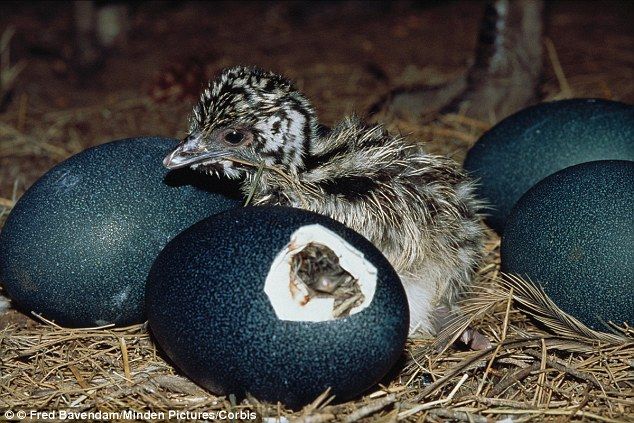Have you ever seen an emu egg up close? These large, vibrant, and uniquely textured eggs are nothing short of mesmerizing. They stand out not just because of their size but also because of their stunning deep green to bluish hue. But beyond their appearance, emu egg hold a treasure trove of interesting facts, cultural significance, and practical uses. Let’s dive into the world of and discover why they’re truly extraordinary.
The Size and Appearance of Emu Egg
When it comes to size, are in a league of their own. They’re about five inches long and can weigh between 1 to 1.5 pounds. That’s roughly the size of ten chicken eggs combined! The shell’s rich, dark green color has a marble-like texture that makes it incredibly durable. This thick shell is not just for aesthetics; it serves as a robust barrier to protect the developing chick inside from predators and environmental factors.
The color of an emu eg.g isn’t just beautiful; it’s practical too. The dark shade helps camouflage the eggs in the wild, blending perfectly with the Australian outback’s grassy and bushy landscapes. Nature truly has a way of creating beauty with purpose!
The Life Cycle of an Emu Egg
The journey of an em.u egg is just as fascinating as its appearance. Emus, native to Australia, usually lay their eggs during the cooler months, from April to August. Female emus can lay up to 15 eggs in one clutch, though not all will hatch.
What’s truly unique about emus is that the males take on the primary parenting role. Once the female lays her eggs, the male takes over, incubating the eggs for about eight weeks. During this time, he barely eats, drinks, or leaves the nest. His dedication ensures the eggs are kept at the right temperature and are safe from predators. When the chicks hatch, they’re fully developed and ready to explore their surroundings under their father’s watchful eye.

Nutritional Value of Emu Eggs
Did you know that em /u eggs are not just visually impressive but also highly nutritious? They are packed with protein, vitamins, and minerals, making them a powerhouse of nutrition. One emu egg contains roughly 1,000 calories, which might sound like a lot, but considering its size, it’s proportionate.
Emu e.ggs are particularly rich in iron, magnesium, and vitamin E. Their yolk has a buttery texture and a slightly richer flavor than chicken eggs. Because of their size, they’re a great option for feeding a crowd or making large batches of dishes like quiches or omelets.
Culinary Uses of Emu Eggs
If you’re a foodie or someone who loves experimenting in the kitchen, an emu egg is a dream come true. Its rich flavor and creamy texture lend themselves well to a variety of recipes. Imagine cracking open one egg to make a giant omelet or using it to bake a massive cake. The possibilities are endless!
However, cooking with emu e.ggs does require some adjustments. Due to their thick shells, you’ll need a bit more effort to crack them open. A small saw or a hammer and chisel often does the trick. Once inside, you’ll be rewarded with a yolk-to-white ratio that’s ideal for creating rich and fluffy dishes.
Emu Eggs in Art and Craft
Beyond the kitchen, emu eggs have found a special place in the world of art and craft. Their durable shells make them perfect for intricate carvings and designs. Artists often use a technique called “eggshell carving” to create stunning works of art. The natural layers of the shell—ranging from dark green on the outside to lighter shades beneath—allow for depth and dimension in the designs.
In some cultures, em.u eggs are also used to create decorative ornaments, jewelry, and even unique keepsakes. Their natural beauty and durability ensure they remain cherished pieces for years.
Cultural Significance of Emu Egg
For Indigenous Australians, em.u egg hold cultural and spiritual significance. They often appear in traditional stories and artworks, symbolizing life, fertility, and sustenance. The emu itself is an important figure in Aboriginal culture, representing endurance and adaptability—qualities mirrored in its eggs.
Some Indigenous communities have used em;u egg as a food source for centuries, incorporating them into their diet and traditional cooking methods. Today, em,u egg continue to be a symbol of the connection between people and the natural world.

Sustainability and Farming of Emu E.gg
Emu farming has grown in popularity, not just in Australia but worldwide. emu egg These farms focus on sustainable practices, ensuring the well-being of the birds while harvesting their emu egg eggs and other products like meat and oil. Emu farming provides a viable livelihood for many and promotes eco-friendly practices.
Harvesting emu eggs responsibly is crucial to maintaining wild populations. Farmers often collect only a portion of the eggs laid by each bird, leaving the rest to hatch naturally. This balance ensures that theemu egg species thrives while allowing humans to benefit from their remarkable eggs.
Where Can You Find Emu Eggs?
If you’re eager to see or try an emu egg, you’re in luck! Many specialty farms and markets offer emu eggs, especially during the laying season. Some farms even ship them directly to your doorstep. Whether you’re buying them for cooking, crafting, or simply admiring, make sure to source them from ethical and sustainable farms.
You might also find emu eggs on display in museums or exhibitions, showcasing their unique emu egg role in history and culture. They’re a great conversation starter and a fascinating glimpse into the natural world.
Conclusion: More Than Just an Egg
Emu eggs are more than just oversized eggs with a pretty shell. They’re a blend of nature’s artistry, nutritional value, and cultural heritage. Whether you’re exploring their culinary potential, admiring their artistic uses, or learning about their role in Indigenous culture, there’s no denying their allure. emu egg Next time you see an emu egg, take a moment to appreciate the marvel it truly is. Who knows? It might inspire your next meal, art project, or even a deeper connection to nature.


 Afrikaans
Afrikaans Shqip
Shqip አማርኛ
አማርኛ العربية
العربية Հայերեն
Հայերեն Azərbaycan dili
Azərbaycan dili Euskara
Euskara Беларуская мова
Беларуская мова বাংলা
বাংলা Bosanski
Bosanski Български
Български Català
Català Cebuano
Cebuano Chichewa
Chichewa 简体中文
简体中文 繁體中文
繁體中文 Corsu
Corsu Hrvatski
Hrvatski Čeština
Čeština Dansk
Dansk Nederlands
Nederlands English
English Esperanto
Esperanto Eesti
Eesti Filipino
Filipino Suomi
Suomi Français
Français Frysk
Frysk Galego
Galego ქართული
ქართული Deutsch
Deutsch Ελληνικά
Ελληνικά ગુજરાતી
ગુજરાતી Kreyol ayisyen
Kreyol ayisyen Harshen Hausa
Harshen Hausa Ōlelo Hawaiʻi
Ōlelo Hawaiʻi עִבְרִית
עִבְרִית हिन्दी
हिन्दी Hmong
Hmong Magyar
Magyar Íslenska
Íslenska Igbo
Igbo Bahasa Indonesia
Bahasa Indonesia Gaeilge
Gaeilge Italiano
Italiano 日本語
日本語 Basa Jawa
Basa Jawa ಕನ್ನಡ
ಕನ್ನಡ Қазақ тілі
Қазақ тілі ភាសាខ្មែរ
ភាសាខ្មែរ 한국어
한국어 كوردی
كوردی Кыргызча
Кыргызча ພາສາລາວ
ພາສາລາວ Latin
Latin Latviešu valoda
Latviešu valoda Lietuvių kalba
Lietuvių kalba Lëtzebuergesch
Lëtzebuergesch Македонски јазик
Македонски јазик Malagasy
Malagasy Bahasa Melayu
Bahasa Melayu മലയാളം
മലയാളം Maltese
Maltese Te Reo Māori
Te Reo Māori मराठी
मराठी Монгол
Монгол ဗမာစာ
ဗမာစာ नेपाली
नेपाली Norsk bokmål
Norsk bokmål پښتو
پښتو فارسی
فارسی Polski
Polski Português
Português ਪੰਜਾਬੀ
ਪੰਜਾਬੀ Română
Română Русский
Русский Samoan
Samoan Gàidhlig
Gàidhlig Српски језик
Српски језик Sesotho
Sesotho Shona
Shona سنڌي
سنڌي සිංහල
සිංහල Slovenčina
Slovenčina Slovenščina
Slovenščina Afsoomaali
Afsoomaali Español
Español Basa Sunda
Basa Sunda Kiswahili
Kiswahili Svenska
Svenska Тоҷикӣ
Тоҷикӣ தமிழ்
தமிழ் తెలుగు
తెలుగు ไทย
ไทย Türkçe
Türkçe Українська
Українська اردو
اردو O‘zbekcha
O‘zbekcha Tiếng Việt
Tiếng Việt Cymraeg
Cymraeg isiXhosa
isiXhosa יידיש
יידיש Yorùbá
Yorùbá Zulu
Zulu